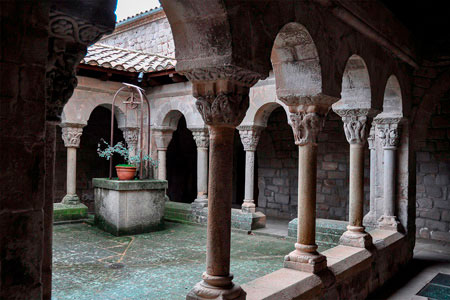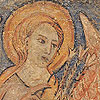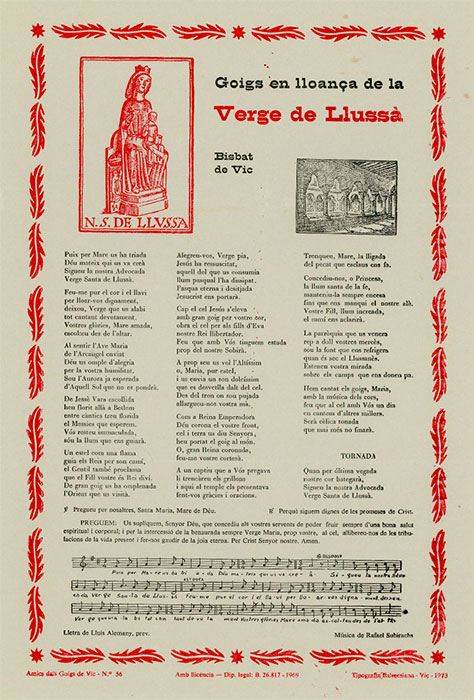The church of Santa Maria de Lluçà has its origins in the territorial reorganisation carried out in a border area between the lands in Islamic hands and those that had already been recovered. This organisation had a military base and the castle of Lluçà formed an important part of that defensive line.
The castle of Lluçà is documented from 905, the date of the consecration of the church of Santa Maria. Everything suggests that the blessing was the result of a reconstruction of an earlier chapel, perhaps from the 9th century. The church acquired a certain importance in the region and at an indeterminate moment it was decided to establish a community of canons there. It is certain that in 1150 there was no community in the church and that in 1168 it was already functioning. It may have been founded around 1154. It is known that the establishment was governed by the Rule of St. Augustine. In 1192 the priory of Lluçà was placed under the protection of Santa Maria de l'Estany.
At the end of the 13th century, the community reached its maximum splendour. It was relatively numerous and took care of the church itself and some others scattered in the surrounding area. The following century was one of decline, the community had been reduced to a minimum. This decline deepened with the commendatory priors, canons from other places who did not live in Lluçà. At the beginning of the 16th century, it had practically ceased to exist, and in the middle of the same century, the state of ruin of the buildings is discussed. In 1609, it joined the chapter of the canons of Barcelona, who continued to maintain the church with a rector, who looked after it until 1849. After the disentailment, it became a parish church, no longer dependent on Barcelona.
The current building is not the one that was founded in 905. Due to its characteristics, it is believed that the church dates from the 12th century, perhaps when the canonry was established. Originally, the church had a single nave headed by a large apse, with a transept topped by two more apses. This building suffered the effects of the earthquakes of the 15th century, which also affected other parts of the monastery. Both the façade and the bell tower are later works, as is the apsidiole on the side of the bell tower, which was also lost, possibly due to the earthquake. It was restored during the 20th century.
The cloister is small and irregular in plan. Its construction is not documented but everything suggests that it dates from the same period as the present church (12th century). It has a great variety of very interesting decorative elements, both in the capitals themselves and in the respective abacuses. It has a total of 22 pieces distributed in the four galleries, of which two capitals have been lost. Two Gothic tombs are preserved in the cloister, the first belonging to Canon Bernat de Merlès, possibly from the 13th century. The second belongs to Canon Ramon de Casovers, who died in 1395.
In 1954, significant remnants of mural decoration were discovered inside the church. These works, now preserved in adjoining rooms of the former monastery, date from the 14th century. Two large panels remain: one depicts scenes from the life of Christ, and the other features scenes from the life of Saint Augustine. Between these compositions was a prominent Pantocrator. Additional smaller fragments also survive, including one with an angel of the Annunciation, another, though badly deteriorated, showing Saint George and the dragon, and a third fragment, which is difficult to identify, depicting two figures before an altar beneath the Serra family coat of arms. The Serra family’s coat of arms appears in various sections of the murals. Notably, a certain Ponç sa Serra served as prior of the monastery from 1348 to 1372, suggesting the execution of these works may be connected to him.
Among the liturgical furnishings and other decorative elements, the iron fittings on the main door stand out for their historical importance and excellent preservation. In the side chapel, where the original apsidiole was once located, a collection of goldsmith's work and liturgical objects is now housed. The Museu Episcopal de Vic holds the wooden altar, painted during the Romanesque period, with three panels beautifully decorated. The same museum also houses a painted altar cross from this period.
- GAVÍN, Josep M. (1984). Inventari d'esglésies. Vol. 15. Osona. Barcelona: Arxiu Gavín
- PLADEVALL I FONT, Antoni (1974). El monestir de Santa Maria de Lluçà. Granollers: Ed. Montblanc-Martin
- PLADEVALL I FONT, Antoni (1984). Catalunya romànica. Vol. II. Osona I. Barcelona: Enciclopèdia Catalana
- PLADEVALL I FONT, Antoni (1997). Santa Maria de Lluçà. Antiga canònica agustiniana. Pladevall
- PLADEVALL I FONT, Antoni (2006). Els canonges de Santa Maria de Lluçà. Parròquia de Santa Maria de Lluçà






















